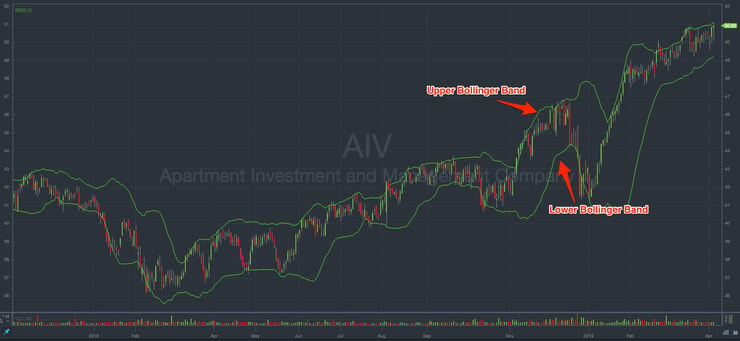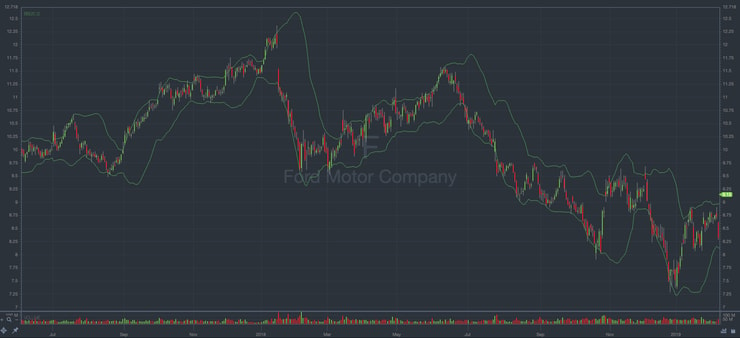Bollinger Bands® might sound like some sort of CrossFit apparatus, but they’re actually a technical analysis tool for stock market traders. Overlaying these easy-to-use and easy-to-understand bands on a stock chart can help traders identify price trends in the stock market.
As a trader, Bollinger Bands® are a great tool for you to employ as part of your all-important stock research. Not only can they help you determine whether a stock is worth buying, but they can also help you plot out the best entry and exit points for your trade.
Curious about how to use Bollinger Bands® in your stock market research?
In this post, I’ll offer an overview of all things Bollinger Bands® — what they are, how they work, and how to use them to your advantage as a trader.
Table of Contents
What are Bollinger Bands®?
Bollinger Bands® are a popular trading tool, but what’s with the odd name? Well, they’re named for the guy who created them, John Bollinger.
John Bollinger is well established in the world of investing: He’s a chartered financial analyst (CFA) and a chartered market technician (CMT) with plenty of financial prowess.
In the early ‘80s, Bollinger created his eponymous bands as a means of making sense of the dynamic volatility that’s present in the movement of stock prices.
How does that work, exactly? Don’t worry; it’s pretty easy to understand.
Bollinger Bands® are a set of two lines representing a positive and negative standard deviation from the simple moving average (also known as the SMA) of a stock’s price.
Traditionally, the lines are positioned two deviations away (positive and negative) from the SMA, but this can be adjusted to your preference.
So … now with Bollinger Bands® explained, how can you actually use them as a trader? Let’s explore.
Benefits of Bollinger Bands®
How do Bollinger Bands® work to your advantage as a trader? Here are some of the benefits of using them …
User friendly. Bollinger Bands® are easy to understand and considered very intuitive, which is a big part of why they’re so popular. Located above and below the SMA, they offer an added parameter for reading the chart with ease.
Flexibility. While Bollinger Bands® are usually set two deviations away from the SMA, this isn’t set in stone. It’s easiest to start with the default settings, and as your understanding and prowess with the bands increase, you can make adjustments as needed.
And the Bollinger Bands® allow for this — they have flexibility. You can adjust the placement of the bands based on your preferences or what you’re looking for specifically in a potential trade.
Identify trends in momentum. Bollinger Bands® can indicate trends. Since strong trends cause expanded volatility, this can make the bands move further apart, making the lower band move in the opposite direction of the trend.
On the other hand, if a trend is drawing to a close, the lower band will move upward, which can act as a sign that the trend is waning for the moment.
No matter which way the trend is moving, Bollinger Bands® can help you figure out if it’s following a pattern.
An easy way to see if the market is overbought or oversold. For many traders, Bollinger Bands® offer an easy way to see if the market is overbought or oversold.
The closer the prices move to the upper band, the more likely the market is to be overbought. On the flip side, as prices move closer to the lower band, it can be an indication that the market is oversold.
No — these aren’t absolutes, but these indications can prompt you to delve in a little deeper to figure out the story with a stock.
Useful for all sorts of traders. Bollinger Bands® aren’t just useful for one type of trader. They can be used by day traders, swing traders, and for longer-term positions. They’re also appropriate for low-priced or penny stocks, as well as higher-priced stocks.
They’re also very popular for forex traders, because currency traders are constantly trying to find trends in price movement. Bollinger Bands® can help them by indicating changes in the volatility of the currencies they’re trading.
Structure in place. Not only did Bollinger create the bands, but he created a list of 22 rules and guidelines for using them appropriately.
This is immensely helpful, as it can give you direction for the best practices with this technical analysis tool. Having rules in place can be very helpful for new traders, giving them a framework.
Check out these rules to get even more ideas for how to use the bands!
How to Read Bollinger Bands®
When reading Bollinger Bands®, what are you trying to see, exactly? Here are the simplest ways to look to the bands for information on trends in stock prices …
Look to the upper band for uptrends. If the uptrend for a stock is strong, it will tickle that upper band on the regular.
It might move toward the middle band, but if it stays above, keeps going upward, and doesn’t dip below the middle band, it’s a good indication that the stock action is going higher and that the activity is strong.
On the other hand, as the bands move further apart, it’s more likely that in time they’ll constrict, which means that you’ll be better able to exit your position.
Remember, of course, that this is just a suggestion of what could happen — not a rule.
Look to the lower band for downtrends. In reading the lower band, you can use the same technique. If a downtrend in stock price is strong, it will play footsie with that lower band frequently. That can be a good indication that the selling activity is strong.
The downtrend is considered strong if the price stays below the middle band and frequently flirts with the lower band.
However, if the price starts going above the middle band or reaching the upper band, this could be a sign that the trend is reversing.
Bollinger Bands® Calculation
How can you calculate the Bollinger Bands®? It’s easy using the Bollinger Bands® formula …
First, calculate the middle band. To do this, figure out the 20-day SMA. Find the average of the closing price of the stock for the past 20 days.
Second, calculate the upper band. To do this, take the 20-day SMA number, then add to it the 20-day standard deviation of price times two.
Third, calculate the lower band. To do this, take the 20-day SMA number, then subtract it from the 20-day standard deviation of price times two.
Setting Up Your Own Bollinger Bands® Strategy

2025 Millionaire Media, LLCOne of the keys to making the most of these bands is to set up your own unique set of Bollinger band trading strategies. Here are some popular trading strategies using Bollinger Bands® …
More Breaking News
- CleanSpark’s Strategic Moves in Bitcoin Trove Provokes Investor Interest
- Asset Entities Surges: What’s Behind the Rise?
- Exploring the Vast Potential in HL Stock
Double Bottoms
One common Bollinger Bands® strategy is what’s called double bottoms.
This is a method of determining a pattern in a chart that helps you establish whether the price action is random or predictable, allowing you to re-test extremes.
It helps you go from reacting to anticipating.
For a double bottom, first you want to make note of the first time the stock’s price touches the lower band. Then, watch and monitor when the next low occurs. This second low might be very similar to the first one, or it might be slightly above or below the lower band.
A price that’s near or at the low can be a good signal to buy, because you’ve found a pattern in the double bottom. Where the stock may seem as if it’s dipping down in price, it may actually be poised for a recovery.
Bollinger Bands® for Determining Stops
Let’s take a breather for a moment so I can add this important fact: Bollinger Bands® can help you determine your stops.
Since Bollinger Bands® are an indicator of volatility with their use of standard deviations, you can get a good idea for exit points for a trade.
To use Bollinger Bands® to determine stops, use this simple technique:
First, figure out the top or the bottom for the stock price within the time frame you’ve chosen.
Next, overlay the Bollinger Bands® with four — yes, four — standard deviation parameters.
Now, draw a line from the top or bottom to the band. Where they intersect is your stop.
Why four, when two would be quite sufficient? Because a wider parameter will help cover your bases. By setting four standard deviations, you’ll account for more potential outcomes, and your exit point will be more reliable.
Reversals
Another way to use Bollinger Bands® for trading is to look at reversals: when a downtrend turns into an uptrend or vice versa.
Usually, it plays out like so … Say the trend has been moving upward, with the price action sticking between the SMA and the upper band.
But now, it’s waving lower, below the SMA and toward the lower band. If this happens once, it might be a fluke. But if it happens again, it could be an indication that soon it will dip below the lower band.
Riding the Bands

It’s a common phenomenon for traders to either buy or sell the moment the Bollinger Band® reaches the upper or lower band.
This may be short-sighted. Even Big Daddy Bollinger himself says that mere contact with the band isn’t in and of itself a must-buy or must-sell signal.
Rather than panicking and taking action the moment the stock price makes contact with the band, try riding the bands. Sometimes a little patience can give the stock room to break out in a big way.
How do you ride? The key is to look at the middle line. If it’s pulling back but not breaking that line, there may still be room for growth.
However, if you start to see a reversal or big acceleration outside of the bands, this could be a sign that it’s time to get out of, or scale down, in your position.
Bollinger Band® Squeeze
When it comes to Bollinger Bands®, the squeeze is a good thing.
When Bollinger Bands® get very close together on either side of the moving average, it’s called a squeeze — and it’s highly desirable.
The squeeze means that at the moment, there’s low volatility, but that this could expand and change in the future, and with it the opportunities for potentially profitable trades.
Key Tips on How To Use Bollinger Bands® in Day Trading
Even with the tips listed, there are certain tips and considerations that can help make it even more useful. Let’s get into some Bollinger band parameters for day trading …
Pay Attention to the Lines and Price Fluctuation
As you’ve probably gathered, success with Bollinger Bands® is all about paying attention to the lines. But don’t lose sight of what these lines are actually monitoring: price fluctuation.
By paying attention to the price fluctuations within and outside of the bounds of the lines, you can look at the price performance over time and really begin to identify trends in the chart.
This can help you make educated guesses about fluctuations that may repeat again, determine intelligent entry and exit points, and much more.
Use Default Settings
Bollinger Bands® are very flexible in that you can adjust where they sit in relation to the SMA. However, particularly if you’ve never used them before, don’t worry about playing with the settings just yet.
Bollinger Bands® aren’t extremely complicated, but it will take a little time to get used to them and to learn how to use the information they offer. Do yourself a favor: start by using the default settings so you can learn the rules before you break them.
Paper trading, or virtual trading, on a platform like StocksToTrade can be helpful at first, to help get into the swing of things and to figure out how Bollinger Bands® work.
As you begin to have successful trades and setups using Bollinger Bands®, you’ll have more freedom to expand and experiment.
Validate Trade Signals
Bollinger Bands® can be extremely helpful in that they can offer even more evidence to support your choice to make a trade.
In addition to validating trade signals, they can be immensely useful in helping you determine entry and exit points and monitoring the volatility of a given security.
However, you should never fall into the trap of blindly following the bands to the point that you buy when the price action dips to the lower band or sell if it touches the upper band.
As with any other technical analysis tool, it’s only one piece of the puzzle. Use the Bollinger Bands® to spur further research rather than spurring you into instant action. Use it to inform moves, but don’t act based only on them.
Follow Chart Patterns
Following chart patterns is the key to making the most of trades.
I joke that I approach stocks like a historian, because I always look to the chart to analyze a stock’s price past to make the best determination about how to move forward in my trading in the future.
Bollinger Bands® can help you make sense of the chart, helping you map out patterns as well as determine and chart a stock’s regular or irregular movement.
It’s important to note that using Bollinger Bands® for technical analysis is not a one-size-fits-all solution for investing in the stock market. It’s only one of many tools that should be in your trading repertoire.
Trade Between the Range
The space between the bars is often considered a “safe” range for trading. It’s kind of like Goldilocks … Not too hot, not too cold — but just right.
This is a way of using the bands, by the way. You’re not just using them with blind faith; you’re using the range to tell you when the stock has moved too far in one direction or the other.
True, this could be done without the Bollinger Bands®. But they do make for a simple and handy tool to do it, so why not? It’s always helpful to have a physical framework in place, and the bands provide that.
The bands can also help you confirm or deny volatility and the size of the float. Basically, this safe range can help you validate whether or not it’s safe to stay holding the stock, since this can help you maximize each swing of the stock.
As a trader, keeping track of too many things in your head can be confusing, and there’s no need. Let the bands do some of the work for you, like helping you determine safe ranges for your trade and how long to maintain a position.
Choose the Best Time Frames
Are there best time frames for Bollinger Bands®? Not necessarily.
Bollinger Bands® can be used in all time frames. The price action won’t change per se, but the size of the moves may differ depending on the day, the time of day, or the time of the year.
Bollinger Bands® are most frequently charted spanning 20 common “periods.”
Some traders might set those periods as days, others might set them as hours. It depends on what your goals are for the trade and what type of information you’re looking for.
Obviously, if you’re a day trader, you’ll need to look at a shorter-term view, but you may want to pull back and look at a longer time period too.
On the other hand, for a swing trader, the hourly fluctuations may not matter as much, and you might want to focus on longer-term time periods.
Which charts are most useful to you will depend on what you hope to gain and your personal trading style.
Increase Your Knowledge

2025 Millionaire Media, LLCIf you want the ultimate tip for making not just Bollinger Bands®, but any and every technical analysis tool work for you, here it is: Increase your knowledge base.
When you actively pursue an education in trading, it will improve everything you do as a trader.
By constantly increasing your knowledge about trading, you’ll begin to understand the market better, which can help benefit your career in many ways.
It helps you make the most of technical and fundamental analysis and the tools to use for the most thorough research. Ultimately, this is how you create smart, well-curated watchlists (like mine) that can assist you in choosing the best opportunities for trades.
Time spent studying the market is always time well spent!
Trading Challenge
How do you increase your market knowledge intelligently? Give your studies focus by joining my Trading Challenge.
My Trading Challenge isn’t your typical day trading class. It offers traders like you access to information via webinars, video lessons, and an online community with other peer traders.
I established this challenge so that new traders could follow my trajectory as a self-sufficient trader who knows what to look for in potential plays. It condenses the lessons I’ve learned in my two decades plus of trading so that you can follow a similar path but in less time.
If you’re ready to take on the trading adventure of a lifetime, apply for the Trading Challenge today!
The Bottom Line
Bollinger Bands® are a tool well worth getting to know and adding to your technical analysis repertoire.
By using these bands to plot out price action, you’ll gain a better idea of entry and exit points and be able to set smart stops for your trades.
Of course, like any other technical analysis tool, they’re meant as only part of your research. Decisions shouldn’t be made on just one tool alone but rather as the culmination of much study and research — both technical and fundamental.
Perform strong research every time to transform your trades from gambles to tactical financial moves!
Have you used Bollinger Bands® in your trading? Tell me how they work for you. Leave a comment to say how you use them!



Leave a reply